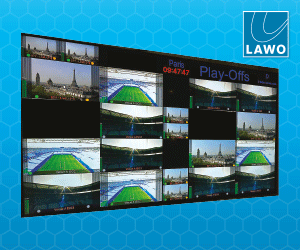This March, Libyas first news channel will turn two. It was launched during the revolution by an ex-Information Minister and journalist to keep the Libyan people informed about the revolution. In an exclusive interview with Vijaya Cherian, the people behind the project, share details of the making of the first news channel in the country […]

This March, Libyas first news channel will turn two. It was launched during the revolution by an ex-Information Minister and journalist to keep the Libyan people informed about the revolution. In an exclusive interview with Vijaya Cherian, the people behind the project, share details of the making of the first news channel in the country post-revolution
Mahmud Shammam is a well known figure in Libya. Following the ouster of ex-Libyan leader Muammar Gaddafi, Shammam, who lived in exile for more than 30 years, was asked to head an entity akin to the Ministry of Media under the National Transitional Council (NTC) in the country while the Libyan government went through a period of transition.
Although the entity was dissolved eventually as various government bodies began to take shape, the ex-Information Minister then moved into his next natural role, which was to invest in the countrys media. Today, Shammams news channel Libya Al Ahrar, popularly known as Libya TV, is said to be one of the most watched news channels in the country.
Shammam is no stranger to the media world. The Libyan-American worked as the editor of the Arabic edition of Newsweek in the US and later, served on the board of Al Jazeera Network. It was his dream to one day help shape the media in his country and the time was ripe when Gaddafi fell.
Unable to open an office in Libya in 2011, Libya Al Ahrar began its operations from Al Rayyan TVs facility in Qatar. Shammam gradually assembled his team which comprised other Libyans.
Mohammed Akary, the first General Manager of the channel; Mojahid Albosifi; Tarik AlGiziry, Sleman Abuzid and Huda Elsrari, present General Manager of the channel all played a crucial role in this project, explains Shammam.
Despite threats from Gaddafis government, the team dispatched reporters to different parts of Libya. The footage was then received via satellite at the Doha office before being retransmitted.
Although the channel began with skeletal facilities at the time of launch, it wasnt until last year under the guidance of UAE-based consultant Broadcast Systems Arabia (BSA) that all of the technical pieces of the jigsaw were put together for the channel and its correspondents to efficiently cover the July 2012 elections in the country.
BSA is primarily run by Mohammed Irfan, a broadcast consultant, who undertook his first Libyan project for Dubai-based Al Aan TV following the dethronement of Gaddafi. While most other systems integrators feared to step into Libya, Irfan went forward to roll out an entire network of radio transmitters for Al Aan TV across the country. The exercise took him all the way from the markets of Libya, where he discovered what kit was available and the best means to ship that which was not available from neighbouring countries, to hiring local people and integrating solutions.
Seven months later, the consultant was back in Dubai as perhaps one of the few professionals with true market knowledge of how to navigate his way through the country and build a broadcast station.
For Shammam, Irfan served as the perfect candidate to advice on how to build studios in the country and what kit to install for the efficient rollout of news and related programmes for the channel.
As a result, while the headquarters remained in Doha, Libya Al Ahrar began its efforts to build its first High Definition studio in Benghazi.
Previously, there were no production studios in Benghazi. Libya Al Ahrar is the first channel to have built a studio there. We also have small offices in Misrata and Tripoli, explains Shammam.
16 Sony HD camera kits were deployed for the entire project while four NLE and GFX rooms were put in place.
The project included several elements including hiring satellite segments for occasional broadcast on Arabsat and Eutelsat; installing permanent satellite uplink facilities from Tripoli, Benghazi and Misrata; purchasing and setting up a dozen DSNG vans; setting up a UPS generator; and more importantly, hiring and training local staff on HD production and equipment.
While all of this seems like part of a standard broadcast setup, it assumed a different meaning in Libya, where the team had to research how to undertake the smallest of tasks. It was as much a learning experience for the channels setup team as it was for Libyan authorities.
A four-camera HD studio, for instance, had to be erected in Benghazi.
The choice of venue posed a challenge in this case. Initially, the team looked at villas but these were not high enough for a studio set up.
We needed the rooms to be at least 5 to 6 ms in height and this was not available, explains BSAs Irfan.
As a result, the channel decided to build its own studio its own hangar setup and rented a three-storey building for the purpose. We needed to hire a civil contractor to undertake this job but nobody knew how to make a studio, forget doing it in 45 days. A local company eventually came forward to undertake this following which we contracted Gulf Media (GMCO), a Qatar-based systems integrator to undertake the deployment of the systems in the studio and their integration.
Although the civil contractor initially asked for two months to do the job as Libya adheres to 8 to 5 work schedules, it later brought in three labour teams to work in three shifts, explains Irfan.
In this way, we completed the hangar setup in 22 days starting from scratch including the steel work, the sandwich panels, acoustics, painting, power and other infrastructure. 70 people worked on this project, adds Irfan.
The building was equipped with 42 air conditioning units, and a 150 kVA generator and UPS system for 24/7 operation.
Alongside the civil works, GMCO worked on putting the solutions together for the studio and this was primarily undertaken in Egypt.
They wanted to build a fully professional SD/HD studio in Benghazi and no other company was willing to take the risk of building a studio from scratch in less than a month or going to Libya. We did this in record time so Libya Al-Ahrar TV could cover the parliament elections on time, explains Eng. Ali Al-Kaabi, GMCOs General Manager.
GMCO, which offers consultancy and technical support for broadcasters and radio stations, undertook the entire studio project for Bengazi from designing the studio and lighting grid to configuring the AV, lighting equipment and devices including the vision mixer, the sound mixer, camcorders, CCU, CG, VTR, frames, racks, consoles, monitors, lighting, cables, and all other studio accessories. GMCO also designed and installed the power and the UPS in addition to undertaking the studio operations and training the crew under BSAs supervision.
The studio had to be up and running in 45 days, explains BSAs Irfan.
The broadcasting equipment was pre installed in Egypt. Gulf Media pre installed all of the studio racks in Egypt, packed them into containers and drove 1800kms from Cairo to Benghazi by road to deliver it. Some of the equipment had to be shipped by air.
One of the big issues was sound proofing the studio.
Acoustics was a huge challenge because apparently, they have not been done in Libya before but GMCO worked on this, he says.
120 live transmissions were done continuously around Libya during the elections by the channel with the help of the DSNG vans.
Even the CNN and the BBC were quoting Libya Al Ahrar, says Irfan.
Logistics was a big concern as all of the equipment was not available in Libya and cargo flights from neighbouring Turkey were limited. In addition, at some point, the airport in Tripoli was closed.
We had to import the generator, the UPS, the DV boxes and other power infrastructure from Turkey. This was the nearest place to acquire good equipment and we got everything in nine days. Of course, this is all fairly new to the Libyan environment so we were breaking new ground even with such basic things, explains Irfan.
Libya Al Ahrar interviewed 86 people for its channel and was keen to hire a new generation of educated young men and women, who could speak both English and Arabic and had an IT background.
We hired the channel manager and an experienced TV broadcast team for the main office. However, for the rest of the posts, the channel focused on hiring young ambitious people with a keenness to learn.
Today, the channel employs 100 staff across Libya, producing programmes for the channel while 50 staff members operate from the channels facility in Doha.
One of the big aspects of this news project was training.
Most of the cameramen we had were used to working with Standard Definition. There was no experience with HD or widescreen so a special production team from Lebanon came down to Libya to train the cameramen, explains Irfan.
The content and daily live shows are produced in the channels studios in Libya and sent via satellite to Doha and from there to Nilesat, Arabsat or Hotbird.
We have three live links from Tripoli, Misrata and Benghazi, explains Huda Elsrari, the channels General Manager.
12 DSNG vans were used to cover the 2012 elections in Libya. Unfortunately, the vans were not registered with Eutelsat for the Occasional Satellite Segments and although it normally takes two months to do this, Eutelsat provided the channel with a temporary licence to work with all 12 antennas from all of the metro cities of Libya.
In the beginning when we just launched, we were on Arabsat, Nilesat, and Hot Bird. But we had problems on Nilesat and couldnt be seen by all the viewers in Libya, explains Elsrari.
This is because most people in Libya tune into Nilesat. But people wanted information and would turn to engineers to help them tune into Arabsat. Many people used to watch the pictures without the voices or remove their children from the environment and watch the channel so they wouldnt speak about it in school. People lived in fear until it was all over, explains Elsrari.
Today, Libya Al Ahrar has gained a reputation in the market for its fearless reportage and has become a game changer in the country. In the meantime, 11 TV channels have come up in Libya with many more in the offing.















































































